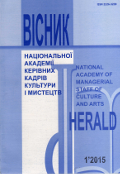ОБРАЗОТВОРЧЕ МИСТЕЦТВО ІТАЛІЙСЬКОГО ВІДРОДЖЕННЯ У КОНТЕКСТІ КУЛЬТУРНИХ ТРАНСФОРМАЦІЙ: ВІД СИМВОЛІЗМУ ДО РЕАЛІЗМУ
Fine art of the Italian Renaissance in the context of cultural transformations: from symbolism to realism
Author(s): Svetlana StoianSubject(s): Anthropology, Visual Arts, Semiology, Ancient World, Middle Ages
Published by: Національна академія керівних кадрів культури і мистецтв
Keywords: symbolism; realism; art, image; humanism; antiquity;
Summary/Abstract: The timeliness of the investigation consists in a clarification of key peculiarities of visual language in the Renaissance that gradually moves from symbolic picturesqueness to allegorical-realistic forms. However, the transformation of the symbolic mystical worldview in the Middle Ages and transition to the primacy of scientific rationality and individualism are not completely manifested in the single-valued characteristics for all geographical and cultural localizations of the Renaissance, for example, of the Italian and the Northern Renaissance. Within the framework of the latter the symbolic trends in the creation of northern artists assume peculiarly colored and unique shapes.The object of the article is to study the essential stages of transformation in the visual arts of the Renaissance concerning its moving away from symbolic picturesqueness and peculiarities of these processes in the territory of the northern countries, which remain significantly committed to the symbolic language.In contrast to the Italian Renaissance, Northern Renaissance demonstrates the adherence to symbolically figurative language that combines with the basic innovative methods. The works of H. Bosch demonstrate the symbolic Christian worldview of the northern countries of Europe, which did not so rapidly break link to the mystical religious traditions of the Middle Ages that were added with alchemic, astrologic and other esoteric knowledge of that time. Peter Bruegel is also under the influence of Bosch's works. He created his early works in a similar symbolically phantasmagoric manner. The works of German genius, A. Dürer, who succeeds in combining the innovation technology with the symbolically allegorical performance, symbolically embody the theme of death and inconstancy of all living beings.
Journal: Вісник Національної академії керівних кадрів культури і мистецтв
- Issue Year: 2015
- Issue No: 1
- Page Range: 11-14
- Page Count: 4
- Language: Ukrainian

